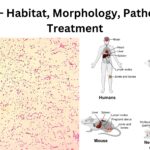IB Biology 19 Views 1 Answers
Sourav PanLv 9November 8, 2024
In what ways is energy released from carbon compounds used by living organisms, and how is it eventually converted to heat?
In what ways is energy released from carbon compounds used by living organisms, and how is it eventually converted to heat?
Please login to save the post
Please login to submit an answer.
Sourav PanLv 9May 15, 2025
Energy released from carbon compounds is crucial for the functioning of living organisms. This energy is primarily derived from the breakdown of organic molecules through processes like cellular respiration. Here’s a detailed explanation of how this energy is utilized and ultimately converted to heat.
Energy Release and Utilization
1. Cellular Respiration
- Process Overview: Cellular respiration is the metabolic process by which cells convert biochemical energy from nutrients (primarily glucose) into adenosine triphosphate (ATP), releasing waste products such as carbon dioxide and water in the process. The overall reaction can be summarized as:C6H12O6+6O2→6CO2+6H2O+energy ATP
- ATP Production: The energy released during the breakdown of glucose is captured in the form of ATP, which serves as the primary energy currency of the cell. ATP is used to fuel various cellular processes, including growth, movement, and biosynthesis of macromolecules like proteins and nucleic acids.
2. Energy Forms and Functions
- Kinetic Energy: ATP can be converted into kinetic energy for muscle contractions and other forms of movement.
- Electrical Energy: In nerve cells, ATP is utilized to generate electrical impulses necessary for communication within the nervous system.
- Biosynthesis: ATP provides the energy required for anabolic reactions, which synthesize larger molecules from smaller ones, essential for cell maintenance and growth.
Conversion to Heat
1. Exothermic Reactions
- Heat Production: The biochemical reactions involved in cellular respiration are exothermic, meaning they release heat as a by-product. This heat contributes to maintaining body temperature in warm-blooded animals and is dissipated into the environment.
- Inefficiency of Energy Transfer: Not all energy from food is converted into usable forms; a significant portion is lost as heat during metabolic processes. For example, during aerobic respiration, only about 40% of the energy in glucose is captured as ATP, while the remainder is released as thermal energy.
2. Heat Loss in Ecosystems
- Unusable Energy: Unlike nutrients that are recycled within ecosystems, heat energy is lost to the environment and cannot be converted back into usable forms by organisms. This necessitates a continuous influx of energy (e.g., from sunlight) to sustain life.
- Role in Homeostasis: The heat generated helps regulate body temperature and supports homeostasis in organisms, allowing them to function optimally despite environmental changes
0
0 likes
- Share on Facebook
- Share on Twitter
- Share on LinkedIn
0 found this helpful out of 0 votes
Helpful: 0%
Helpful: 0%
Was this page helpful?




